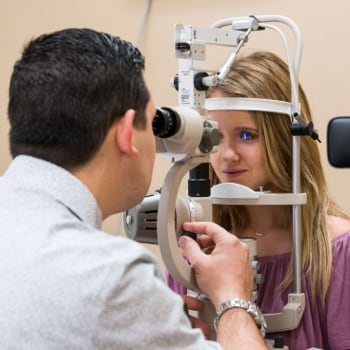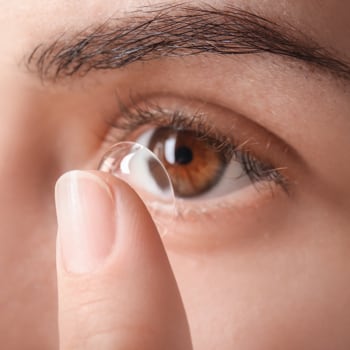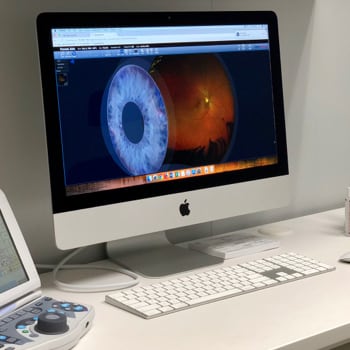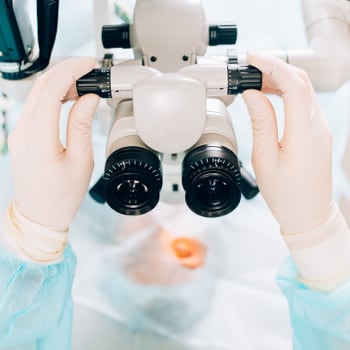By Dr. Hiren Patel, OD
Imagine gardening in your backyard on a hot and sunny Austin day. You wipe the sweat off your forehead, thinking that some got into your eyes because of how irritated they feel. Allergens are high this time of year for those sensitive to cedar, but you feel every year it’s getting worse and worse. You’ve tried eye drops for allergies and while they seem to help a little, it doesn’t seem to do a good enough job. It turns out that the main issue could be something else entirely: pingueculas.
Figure 1: pinguecula on left and right side of the eye, indicated by the blue arrows
The first time I heard the word pinguecula, I thought it was some strange mix between pink eye and Count Dracula. A pinguecula is simply a yellowish-colored lesion that is growing over the white of the eye. Pingueculas often occur on the nasal (nose-side) half of the eye, but often happen on both sides of an eye as seen in figure 1, and can affect both eyeballs equally. They are caused primarily by outdoor environmental factors such as wind, dust, and ultraviolet light exposure. Living closer to the equator, like here in Central Texas, puts you at a higher risk of getting them.
Once a pinguecula develops on an eye, it can cause ocular surface issues. This includes redness and a feeling like something is stuck in the eye. A pinguecula can become inflamed, causing pingueculitis, which can be alleviated with prescription eye drops.
If you aren’t sure if you have a pinguecula, ask your optometrist! Using a biomicroscope to examine the eyes, it is an easy diagnosis to make for our optometrists during an eye exam. Sometimes a pinguecula can be an off-white color and difficult to see without the help of magnification. Optometrists can let you know how you are doing in terms of protecting your eyes from harmful ultraviolet rays!
We know what causes it and know how it feels, but how do we treat it? Unfortunately, there are no magic eye drops to make a pinguecula go away. The only way to have a pinguecula go away is by surgical removal. That is rarely ever necessary, instead pingueculas are treated by artificial tears to reduce irritations, and sunglasses or goggles to protect from ultraviolet light or wind.
If left untreated for years, a pinguecula can eventually worsen into a pterygium. This is when the lesion starts to grow onto the clear cornea on the front of the eye, leading to worsened redness, more irritation, and eventually blurry vision. It may be a good idea to have a pterygium surgically removed to improve vision if it is causing issues such as astigmatism or blocking the view through your pupil.
If there’s one thing that I want you to remember from all of this, it’s to wear sunglasses. Whether you already have a pinguecula or are at a higher risk of one by living in a sunny area, it is a great idea to wear UV protective sunglasses. That means you: Austinites, Pflugervillians, Round Rockers, and Cedar Parkans.













